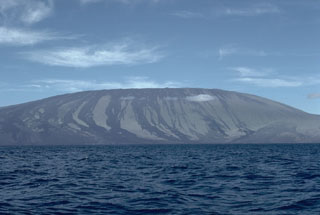Report on Wolf (Ecuador) — 23 February-1 March 2022
Smithsonian Institution / US Geological Survey
Weekly Volcanic Activity Report, 23 February-1 March 2022
Managing Editor: Sally Sennert.
Please cite this report as:
Global Volcanism Program, 2022. Report on Wolf (Ecuador) (Sennert, S, ed.). Weekly Volcanic Activity Report, 23 February-1 March 2022. Smithsonian Institution and US Geological Survey.
Wolf
Ecuador
0.02°N, 91.35°W; summit elev. 1710 m
All times are local (unless otherwise noted)
IG reported that the eruption at Wolf continued during 23 February-1 March. Daily thermal alert counts, as high as around 253, indicated active and advancing lava flows on the SE flank.
Geological Summary. Volcán Wolf, the highest volcano of the Galápagos Islands, straddles the equator at the north end of the archipelago's largest island, Isabela. The edifice has steeper slopes than most other Isabela volcanoes, reaching angles up to 35°. The summit caldera is 6 x 7 km across and 700 m deep. A prominent bench on the west side of the caldera rises 450 m above the caldera floor, much of which is covered by a lava flow erupted in 1982. Radial fissures concentrated along diffuse rift zones extend down the N, NW, and SE flanks, and submarine vents lie beyond the N and NW fissures. Similar unvegetated flows originating from a circumferential chain of spatter and scoria cones on the eastern caldera rim drape the forested flanks to the sea. The proportion of aa lava flows exceeds that of other Galápagos volcanoes. An eruption in in 1797 was the first observed and documented in the Galápagos Islands.
Source: Instituto Geofísico-Escuela Politécnica Nacional (IG-EPN)

